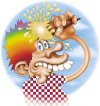First - I may be going about this the wrong way, or also, I may not have a firm grasp of how to use what is available...
I have a pedalboard type layout that is all effects; all 9 switches are assigned to effects. Two switches already have a per-preset function that changes channels to get variation on those exact effects. A third switch toggles the tuner. Those three work exactly as expected.
Now I want to add a multiband compressor to the situation. There is room for it in the row - I have already loaded the block and edited it to my liking. But my instinct to assign it "under" my switch labeled "flanger" has failed. I have set up per-preset #4 to engage it on Hold, and it is visible in the FC control view in FM9Edit. When I hold down that flanger switch to get the compressor, I get the message that Comp1 is not in this preset. The flanger effect still works fine. I wanted the second function for that switch to engage the multiband compressor. FWIW, I don't expect to ever use those two at the same time; it would be one or the other.
So - am I going about this wrong?
If the way I am trying to do it is not workable, what approach would work?
Thank you!
Jeff
I have a pedalboard type layout that is all effects; all 9 switches are assigned to effects. Two switches already have a per-preset function that changes channels to get variation on those exact effects. A third switch toggles the tuner. Those three work exactly as expected.
Now I want to add a multiband compressor to the situation. There is room for it in the row - I have already loaded the block and edited it to my liking. But my instinct to assign it "under" my switch labeled "flanger" has failed. I have set up per-preset #4 to engage it on Hold, and it is visible in the FC control view in FM9Edit. When I hold down that flanger switch to get the compressor, I get the message that Comp1 is not in this preset. The flanger effect still works fine. I wanted the second function for that switch to engage the multiband compressor. FWIW, I don't expect to ever use those two at the same time; it would be one or the other.
So - am I going about this wrong?
If the way I am trying to do it is not workable, what approach would work?
Thank you!
Jeff

